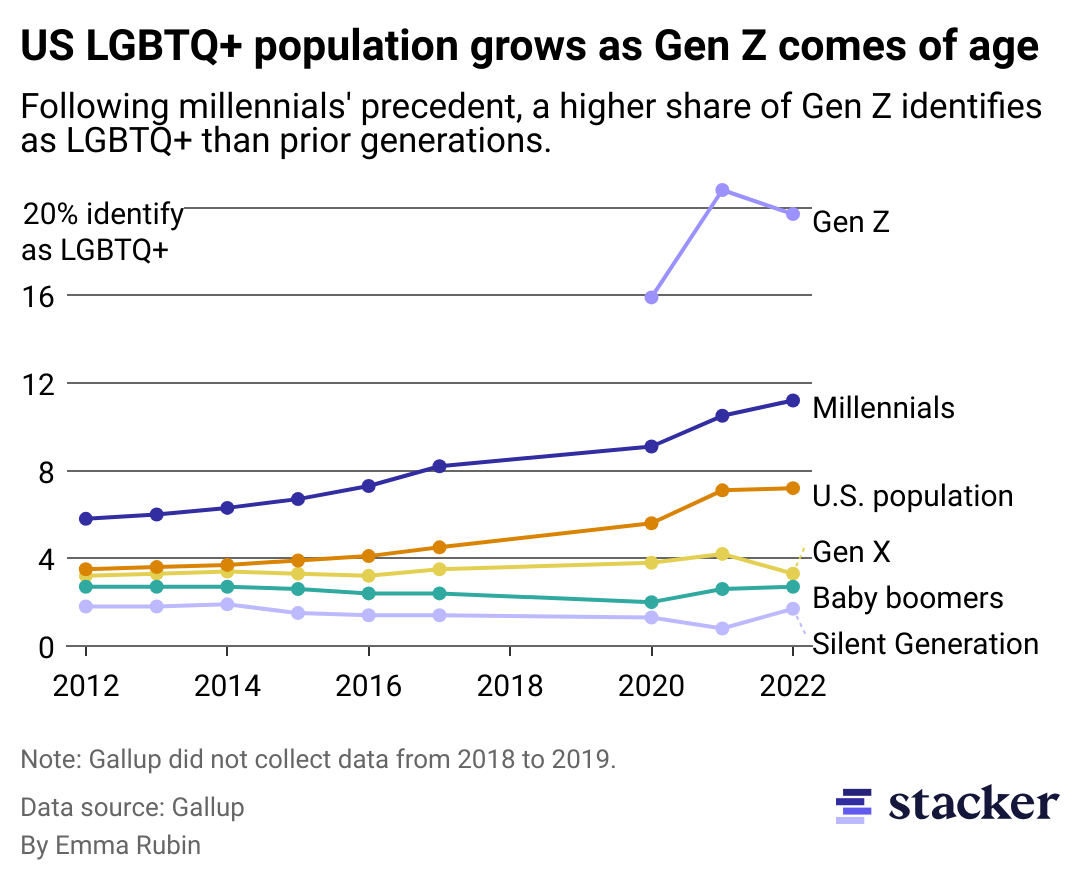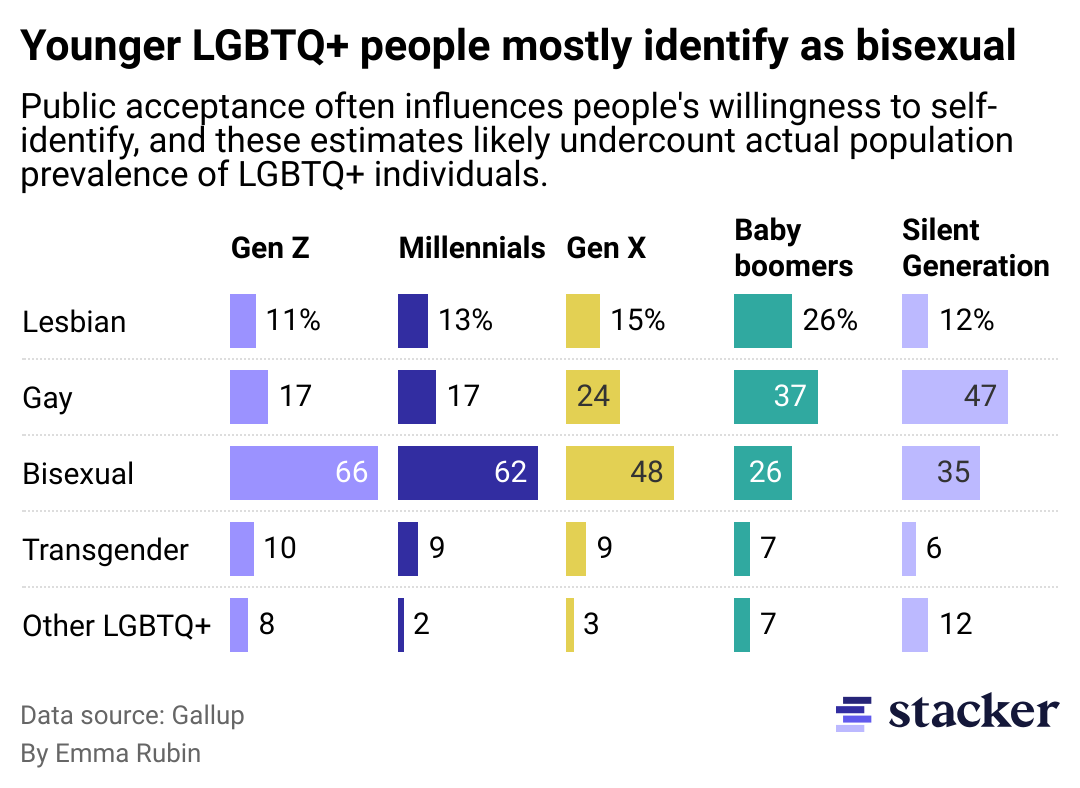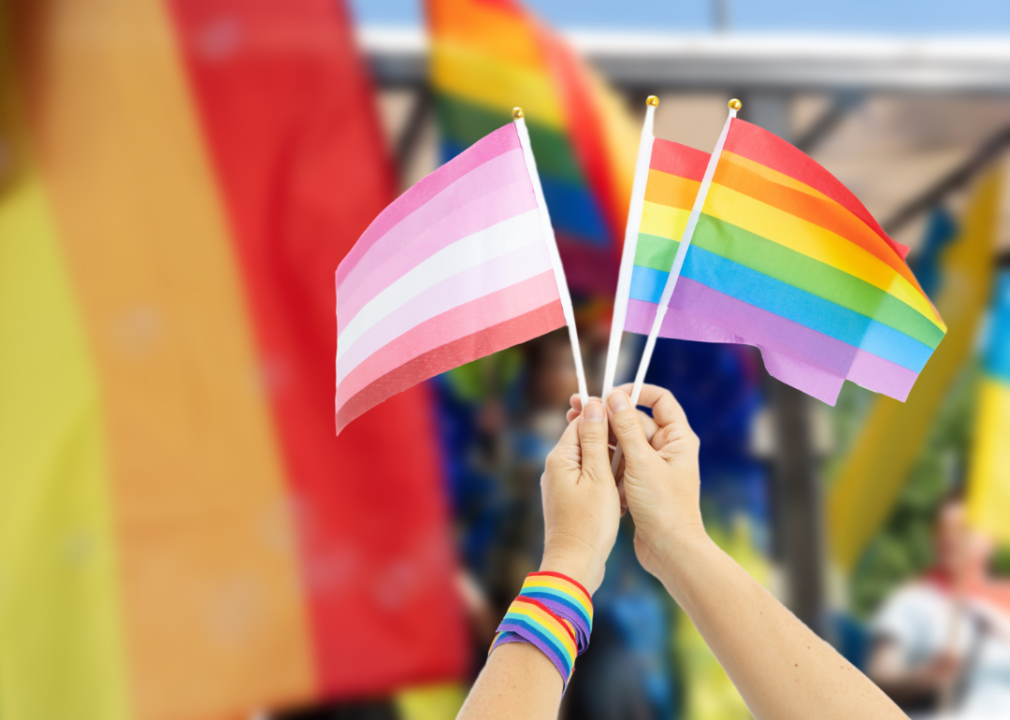These 2 charts show how Gen Z is changing the makeup of the LGBTQ+ population in the US
Nuva Frames // Shutterstock
These 2 charts show how Gen Z is changing the makeup of the LGBTQ+ population in the US
Diverse group of friends taking selfie outdoors.
Young Americans are embracing their LGBTQ+ identities despite the emergence of new, discriminatory laws targeting them around the country.
Using survey data from Gallup, Stacker looked at the rising share of Americans who identify as LGBTQ+ and how younger generations are owning their sexual identities in observance of the 35th National Coming Out Day on Oct. 11.
About 7% of Americans identify as lesbian, gay, bisexual, transgender, queer, or some other orientation that doesn’t conform to heterosexual and cisgender norms. That percentage is markedly higher—about 20% as of 2022—among members of Generation Z, Gallup reports.
This increase comes as politicians take aim at LGBTQ+ people’s civil rights more aggressively than at any other time in history. As of this writing, lawmakers have introduced around 500 bills in state legislatures across the U.S. just this year that have been deemed anti-LGBTQ+ by the advocacy group Human Rights Campaign, leading the nonprofit organization to declare its first national emergency in June. Furthermore, countries such as Canada have warned residents about traveling to the U.S. because of the antagonization against LGBTQ+ people.
Despite this, research points to young people coming out earlier than previous generations, said Keygan Miller, interim director of public training for The Trevor Project, an advocacy organization focused on lowering youth LGBTQ+ suicide.
“While we can’t attribute this to any one reason, Gen Z has had more access to language, education, and representation around LGBTQ people and identities than any prior generation,” Miller said.
Most people who ultimately identify as lesbian, gay, or bisexual have an inkling they don’t conform to a straight identity by the age of 14, according to a survey from the Pew Research Center. Sharing that identity out loud with friends, colleagues, and loved ones, however, can be stressful and sometimes dangerous. Over one-quarter of LGBTQ+ youth have experienced homelessness or housing instability, according to The Trevor Project. Centers for Disease Control and Prevention data shows that they are also four times more likely than their peers to attempt suicide. They’re also more likely to be the victims of violent hate crimes.
The concept of National Coming Out Day began in 1988, as the country was in the midst of the HIV/AIDS epidemic. At the time it was first being celebrated, the term “coming out of the closet” was still new for Americans. Scholars have traced its origins to the years following World War II when LGBTQ+ Americans suffered brutal hardship alongside other soldiers, opening their minds and winning their friendship and support in the postwar years.
The Trevor Project encourages people to come out on their own terms while recognizing that some may never disclose their sexual orientation or gender identity to everyone in their lives. “There is no right or wrong way to do it,” Miller said. “There are many valid reasons for why a young person may choose not to share their identity with those around them.”
Editor’s note: If you or someone you know are experiencing a mental health crisis or thoughts of suicide, call the Suicide and Crisis Lifeline at 988 for professional help.
![]()

Emma Rubin // Stacker
1 in 5 of America’s youngest generation identify as LGBTQ+
Line chart showing U.S. LGBTQ+ population grows as Gen Z comes of age. Following millennials’ precedent, a higher share of Gen Z identifies as LGBTQ+ than prior generations.
Both millennials and Gen Z identify themselves as part of the LGBTQ+ spectrum at a significantly higher rate than Gen X, boomers, and the Silent Generation, Gallup data shows.
In this analysis, the Silent Generation refers to people born in 1945 and earlier, baby boomers are 1946-1964, Gen X is 1965-1980, millennials are 1981-96, and Gen Z is 1997-2004.
The uptick in identification trends recorded by Gallup since 2012 mirrors a steady increase in LGBTQ+ identifying people across the U.S. population as a whole, as well as support for them. A majority of Americans held the opinion that same-sex marriage was morally wrong until around 2011 when support for legalization of LGBTQ+ marriage reached 53% of the population.
“It’s one of the most remarkable societal changes we’ve seen in our data. It’s a very big increase,” Gallup analyst Justin McCarthy said. “We saw a nation of people make a total about-face on their views on some of our long-standing measures.”

Emma Rubin // Stacker
Bisexual identities more common with younger generations
Split bar chart by generation showing younger LGBTQ+ people mostly identify as bisexual. Public acceptance often influences people’s willingness to self-identify, and Gallup estimates may undercount actual population prevalence of LGBTQ+ individuals.
Bisexual identities have become much more common in younger generations of Americans, with more than 60% of LGBTQ+ populations under the age of 43 identifying as such.
Not everyone who identifies as LGBTQ+ is “out” to all people in their lives in the same way, however. A separate survey from Pew asked about the degree to which LGBTQ+ people are out in their relationships, and they found that bisexual individuals are much less likely to be out with all or most of the people in their lives compared to gay and lesbian individuals. One of the reasons for this may be a result of bisexual identity invalidation, which occurs when someone negates, denies, or fails to accept the identity of a bisexual person.
As support for same-sex marriage and LGBTQ+ people serving in the military has increased in recent years, support for transgender people has not moved at the same pace. According to a survey from the Pew Research Center, the percentage of respondents who say gender identity can differ from sex assigned at birth has gone down since 2017. Gallup surveys have found similar trends, with more respondents this year than two years ago saying changing one’s gender is morally wrong.
The trend comes as more Republican lawmakers push for laws that would limit transgender children’s access to health care and ability to participate in youth sports teams that align with their gender identities. As a result, views on transgender identities now differ starkly among people who identify as Republicans or Democrats.
“It’s not surprising that anti-trans rhetoric has impacted people’s views on the trans community and perpetuated harm,” Miller said, pointing to Trevor Project polling showing that fewer than 1 in 3 Americans know a transgender person. They urged people to “prioritize listening to trans people on issues impacting our community.”

Canva
Coming Out 101: What does it mean to be uniquely you?
Flags fly at a pride celebration.
As members of America’s youngest generation embrace their LGBTQ+ identities at the highest rates of any other, The Trevor Project suggests allies consult its Coming Out Handbook for ways to support loved ones who may be on their own journey to acceptance. A few important points to keep in mind:
- Questioning your identity is healthy.
- Think of the sex you’re assigned at birth as a rough draft written without your participation that you now get to revise. It is not necessarily your true gender identity.
- There are endless ways to live out your gender identity whether male, female, nonbinary, or another identity. This is referred to as gender expression.
- Explore the aspects of femininity, masculinity, or androgynous identities that make you happiest.
- There is no perfect moment at which you should come out to those in your life, and some people prefer to test the waters ahead of time with questions about a celebrity’s sexuality or a current event.
- Consider the people you feel safest around and who you think will support you no matter what.
Story editing by Ashleigh Graf. Copy editing by Tim Bruns.

